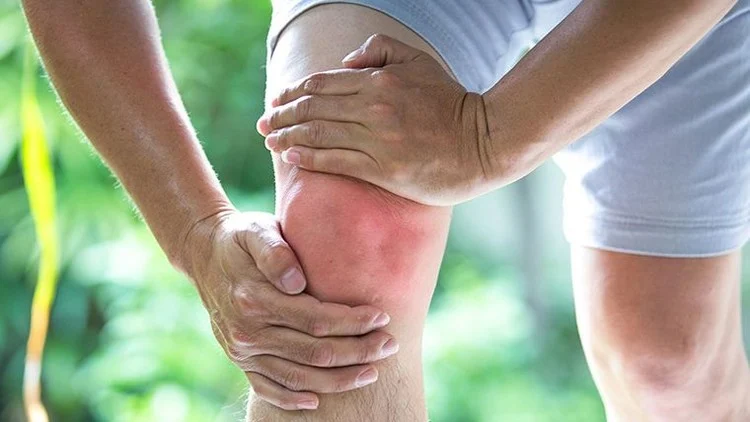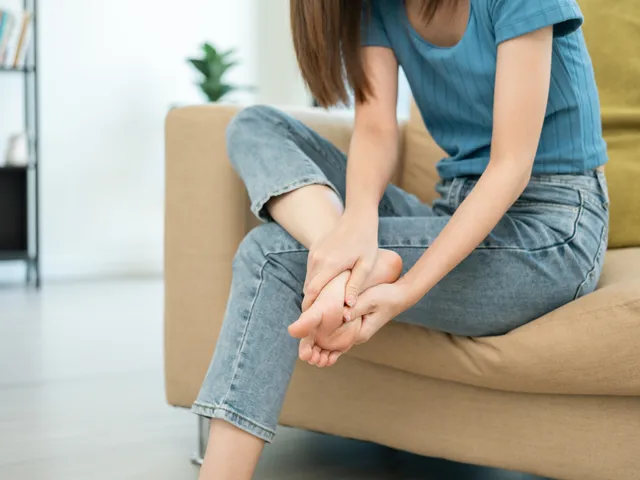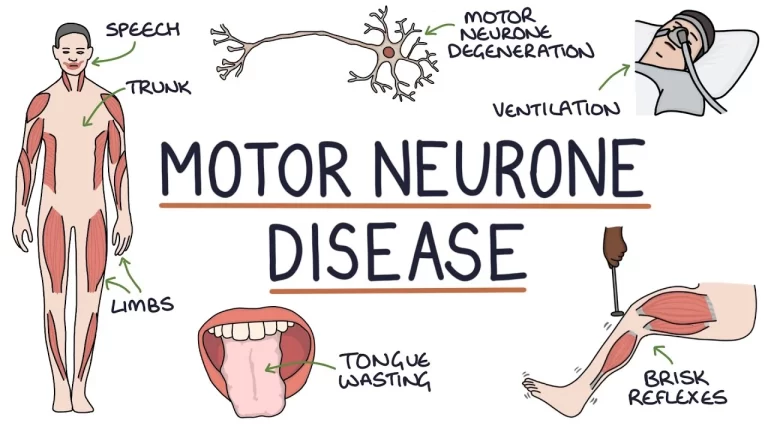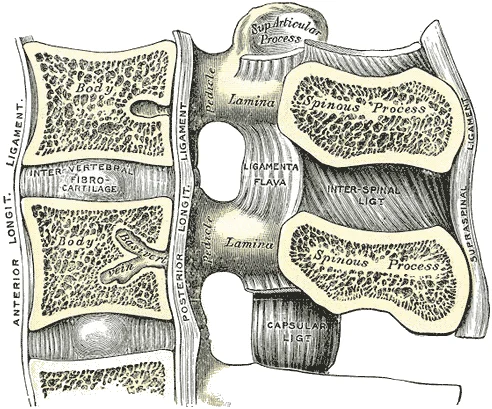Knee Flexion Pain
Introduction
Do you have knee pain when you bend? You’re not by yourself if so. This kind of pain, which can be minor or severe, affects a lot of people. It’s crucial to consult a physician for a precise diagnosis because there are numerous potential reasons why knee pain may occur when bending. Options for treatment can be considered after the cause has been identified. You can do a few things to lessen the pain in between.
You may have an injury or another medical condition if bending your knee causes pain. The location and severity of the pain can vary depending on the underlying cause.
You bend your knees a lot during the day. Daily tasks like sitting in a chair and ascending stairs require movement. Additionally, when performing activities like lunges and squats, you bend your knees.
Home remedies can be used to address mild causes of knee pain. Others need medical care. We’ll go over the many reasons for knee pain when bending here and warning indications that you should consult a physician.
Do you have knee pain when you bend?
You’re not by yourself if so. This kind of pain, which can be minor or severe, affects a lot of people. It’s crucial to consult a physician for a precise diagnosis because there are numerous potential reasons why knee pain may occur when bending. Options for treatment can be considered after the condition has been identified. You can do a few things to lessen the pain in the interim.
What is Knee Flexion Pain?
Knee flexion pain refers to discomfort or pain experienced when bending the knee. It can result from various causes, including injury, overuse, inflammation, or underlying joint conditions such as arthritis or meniscus tears. This type of pain may affect mobility, daily activities, and overall knee function. Identifying the cause is essential for effective treatment and prevention.
As the largest joint in your body, the knee bears the pain of your weight while you move. It is one of the most frequently injured joints as a result. Knee pain can be either a short-term, transient condition or a chronic, long-term one that requires medical evaluation and treatment.
The section or parts of your joint that are injured typically determine where you experience knee pain. You may experience pain:
- Near the area behind or above your knee (typically a problem with your ligaments, tendons, or muscles).
- Deeper within your knee (pain originating from cartilage or bones).
- In several areas of your leg or knee. Sometimes, knee pain can extend to other parts of the body. On one side, you could experience pain that occasionally appears to originate from the rear of your knee. Additionally, pain may radiate to the thigh or lower leg, which are regions surrounding your knee.
Knee pain might be intermittent. For instance, you may experience knee pain that improves with rest when you move or bend your knee. Additionally, some people experience pain at different times of the day. When you wake up in the morning, you can experience additional pain. Knee pain at night is also typical, particularly if you were physically busy throughout the day.
By using over-the-counter (OTC) pain medicines and taking a vacation from physical activity, you can typically treat knee pain at home. If you’re experiencing pain that interferes with your everyday activities or makes it difficult for you to move, see a doctor.
Causes of Knee Flexion Pain
Knee pain during bending can be caused by several factors. Among the potential circumstances are:
- Iliotibial (IT) band syndrome can cause burning pain outside of your knee that travels to your hip or thigh; hamstring tendonitis can cause pain behind your knee and thigh; patellofemoral syndrome can cause a dull ache in front of your knee; patellar tendonitis can cause burning and pain in or at the base of your kneecap; and quadriceps tendonitis can cause pain above or in front of your knee.
- Damage or trauma to the knee joint or ligaments, which may result in acute pain, swelling, and trouble moving the knee; osteoarthritis, which produces diffuse knee pain, swelling, and stiffness in the morning; and knee bursitis, which may cause swelling, warmth, and pain over or below the knee.
- Baker’s cyst may result in swelling and pain behind your knee.
Pain above the kneecap when bending
When bending, if you get soreness above your knee, you might have:
- Quadriceps tendonitis
- Osteoarthritis
- Knee bursitis
- Pain when bending in front of the kneecap
The following are some possible reasons for kneecap pain:
- Patellofemoral pain syndrome
- Patellar tendonitis
- Quadriceps tendonitis
- Knee bursitis
- Patellar fracture
Since the knee is a complicated joint, knee pain can be caused by a variety of conditions. The following are a few of the most typical reasons for knee pain:
- Arthritis
- Jumper’s knee
- Knee injury
- Runner’s knee
- Joint infection
- Bursitis
- Fibromyalgia
Arthritis
Although there are numerous varieties of arthritis, osteoarthritis is the most prevalent. The cartilage that cushions your knee deteriorates with osteoarthritis (OA), which can eventually lead to the bones of your knee joint rubbing against one another and breaking down as well.
The majority of OA patients are elderly, with over 73% of those affected being over 55. Around the world, 365 million people suffer from knee OA, making the knee the most often affected joint.
The knee may also be impacted by rheumatoid arthritis, an inflammatory disease in which your immune system targets healthy joint tissue. Psoriatic arthritis, which affects those who have psoriasis, is another kind. Knee pain, swelling, and trouble bending or straightening your knee can be symptoms of any kind of arthritis. Another form of arthritis is gout. Small uric acid crystals that develop in and around the knee joint are the source of sudden flare-ups of excruciating pain and swelling.
Gout affects 1-2% of the population in the UK, primarily post-menopausal women and males over 30. The symptoms normally appear quickly and go away after three to ten days. Regretfully, the majority of patients get more gout attacks in the year that follows.
Jumper’s knee
Jumper’s knee is known medically as patellar tendonitis, which is an inflammation of the patellar tendon. Your shin bone (tibia) and kneecap (patella) are joined by your patellar tendon.
Jumper’s knee is a common sports-related injury caused by repetitive hits to the ground that strain the tendon. As the name suggests, playing basketball or other activities that involve a lot of hopping on hard surfaces may be the reason.
Your patella tendon becomes weaker due to inflammation and may tear if treatment is not received. According to a study, males not great athletes are twice as likely as females who are not great athletes to suffer from jumper’s knee.
Knee injury
Ligament ruptures, sprains, strains, fractures, and dislocations are common knee injuries. These could be caused by falls or direct knee injuries.
A knee sprain occurs when your knee’s ligaments overstretch or rip partially. Twisting with a planted foot, such as after an awkward landing during sports, is a typical cause of knee sprains.
Ligament rupture: A ligament rupture occurs when the knee ligament completely tears, causing it to split in two. Surgery can be necessary because this is more serious than a knee sprain.
A muscle strain happens when one of the knee’s muscles is overextended, causing a tear in the affected area. Playing sports, carrying large objects, or overusing the muscle can all cause it. A knee fracture occurs when a bone in the knee breaks. Although knee osteoporosis can make the bones too hard and fracture with little impact, this is typically caused by a fall or accident.
Dislocation: Two to three percent of all knee injuries are caused by patellar dislocation. Your kneecap falls out of position at this point, usually to the side. It frequently results from a direct hit to the inside of your knee or a twisting injury.
Runner’s knee
Chondromalacia patella, a disorder that frequently affects runners, is known by the nickname “runner’s knee.” Your kneecap hurts when it particles on your thigh bone because the cartilage behind it deteriorates.
People who participate in sports like running, which causes repetitive strain on the knee, frequently develop runner’s knee. Due to the increased strain on their knee joints, people who are overweight are also more susceptible.
Joint infection
Infections caused by bacteria, fungi, or viruses can occasionally travel to your knee joint. This is a dangerous medical disorder known as septic arthritis or a knee joint infection.
Suddenly knee pain and swelling without any visible injuries is the most common indicator of a knee joint infection. Get medical help right away if you also have a fever, chills, or feel poorly in general. If you have a joint infection, you will require medicines and joint drainage.
Bursitis
An inflammation of the bursa, a little sac filled with fluid, close to your knee, is known as knee bursitis. The purpose of the numerous bursae in and around your knee joint is to lessen friction between the surrounding tissues.
These sacs can put pressure on the surrounding tissue and create excessive amounts of fluid when they are inflamed. This might restrict knee movement and cause pain.
Fibromyalgia
Fibromyalgia is a chronic (long-lasting) illness that results in severe fatigue and pain throughout the body. In the UK, 2% of people suffer from it, while 90% of fibromyalgia sufferers are female.
In addition to having a 20% increased risk of depression or persistent anxiety, fibromyalgia can impair memory and sleep. A dull pain is a common description of fibromyalgia pain, which can impact your knees and other joints.
One or both of your knees may hurt all the time or only sometimes, and you may also have stiffness and swelling. Although it is not a hallmark of fibromyalgia, knee pain can strike those who have it, frequently in conjunction with pain in other areas of their bodies.
Diagnosis
To determine the source of your knee pain, a physician will do the following tests:
Blood tests that enable your doctor to look for indications of infection or systemic inflammatory disease, such as rheumatoid arthritis (RA), imaging tests, such as an X-ray or MRI scan, to examine the bone and tissues in your knee, and physical examination, which enables the doctor to check for joint swelling, instability, and signs of swelling
In certain situations, your physician may recommend testing like:
- X–ray. An X-ray, which can assist in identifying bone fractures and degenerative joint disease, may be the first procedure your doctor suggests.
- CT scan (computerized tomography). CT scanners make cross-sectional images of your body by combining X-rays acquired from a variety of angles. Subtle fractures and other bone problems can be diagnosed with CT scans. Even when the joint is not inflamed, gout can be reliably detected by a certain type of CT scan.
- Ultrasound. This technique creates real-time photographs of the soft tissue structures inside and surrounding your knee using sound waves. During the ultrasound, your doctor might want to move your knee in various ways to look for the particular problem.
- MRI stands for magnetic resonance imaging. An MRI produces three-dimensional images of the interior of your knee using radio waves and a strong magnet. This test is especially helpful in identifying damage to soft tissues like muscles, cartilage, ligaments, and tendons.
- Laboratory tests. Blood tests and occasionally an arthrocentesis procedure—in which a tiny amount of fluid is extracted from inside your knee joint with a needle and submitted to a lab for analysis—are likely to be performed if your doctor detects an infection or inflammation.
Treatment
Medications to treat knee pain
To treat the knee pain and any other symptoms you’re having, your doctor may recommend taking some medicine.
The majority of patients can use acetaminophen (Tylenol®) or over-the-counter NSAIDs (ibuprofen, aspirin, and naproxen). If you have liver or renal illness, or if you take these drugs for more than 10 days in a row without consulting your doctor, stop taking them.
Injections
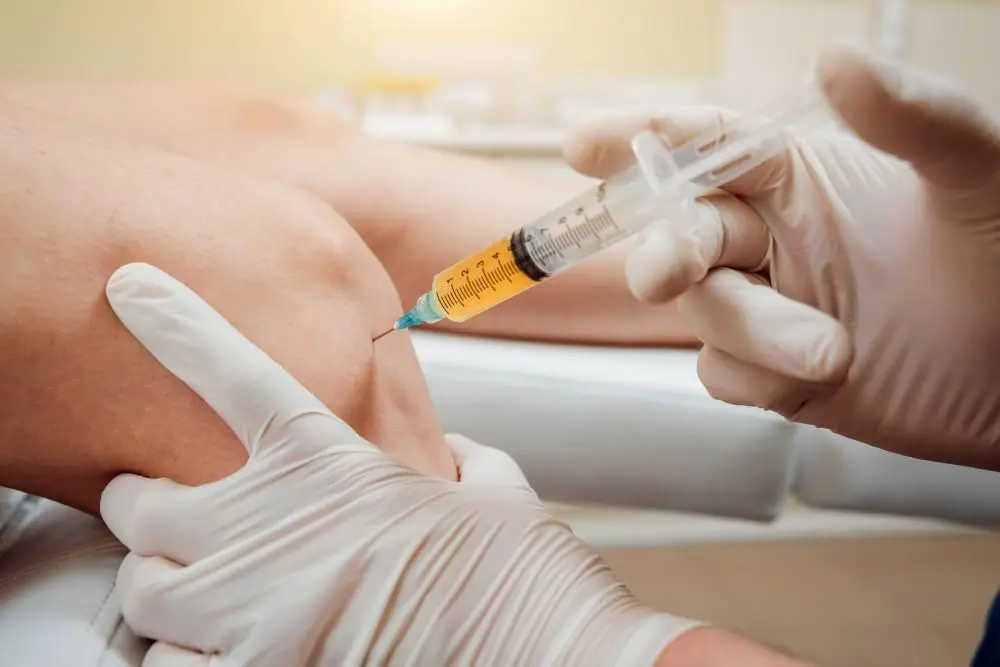
In certain situations, your physician might advise injecting drugs or other materials straight into your joint. Among the examples are:
- Corticosteroids. A corticosteroid medication injected into your knee joint may help relieve pain that may continue for several months and lessen the symptoms of an arthritis flare. Not every situation can benefit from these infusions.
- Hyaluronic acid. To increase mobility and reduce pain, hyaluronic acid, a viscous fluid that resembles the fluid that lubricates joints naturally, can be injected into your knee. Relief from one or a series of shots may last up to six months, despite conflicting study results about this treatment’s efficacy.
- Platelet-rich plasma. Numerous growth factors that appear to lessen inflammation and encourage healing are concentrated in PRP. PRP may help some people with osteoarthritis, according to some research, but additional research is required.
Physical therapy
You can learn particular exercises for your disease from a physical therapist. Your knee’s strength, range of motion, and flexibility will all be enhanced by these workouts.
Exercises to improve flexibility and range of motion
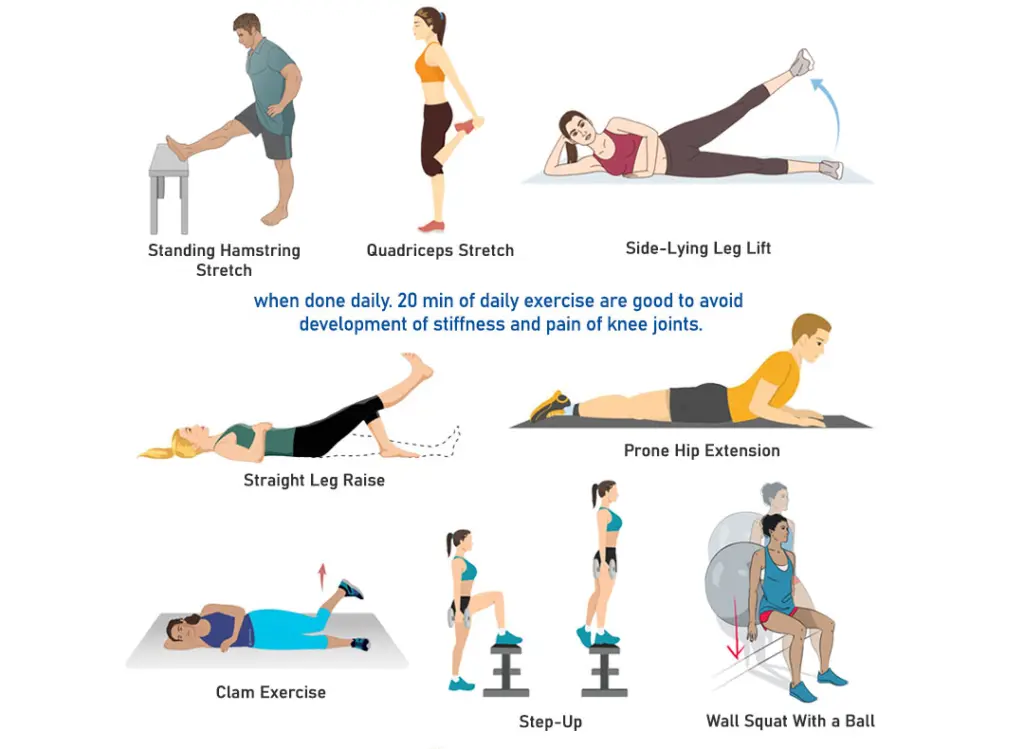
Exercise can significantly increase knee range of motion and flexibility. The easiest method to improve knee flexibility and maybe lessen knee pain is to stretch frequently. Knee circles, hip extensions, side leg lifts, lunges, and squats are all great ways to stretch the knee joint. Knee stability can also be increased by including strength training activities in your regimen. Exercises that require knee movement against resistance from weights or bodyweight, such as leg curls and squats, enhance range of motion and muscle control, which, over time, contributes to increased joint stability. Simple exercises like ankle rotations can help maintain the health of your knee joint by increasing circulation around it.
Regular exercise can have a huge positive impact on knee range of motion and flexibility, whether you choose to conduct strengthening or stretching exercises.
Orthotics
Your foot and ankle can be stabilized using orthotic shoe inserts. By lessening the strain on your knee, they help ease pain.
You may be able to get an orthotic at a pharmacy, depending on your situation. As an alternative, a doctor might recommend a specially designed shoe insert.
Knee brace

Your knee is held in position and supported by a knee brace. Maintaining the alignment of your knee is how knee braces function. Usually composed of metal or rigid plastic, they have straps that fit around your leg and knee and cushions. Which kind of brace you’ll need and how frequently to wear it will be determined by your provider.
Immobilization
A doctor may prescribe a cast or brace if your knee pain is the result of an injury. By keeping you from moving your knee, this will protect it, reduce pain, and promote recovery.
Surgery
You could require surgery if nonsurgical therapy is ineffective for your disease. Generally speaking, only severe instances necessitate surgery. Knee problems are treated with a variety of surgical techniques.
Here are a few cases:
Total knee replacement, tibial tubercle transfer, meniscus repair, anterior cruciate ligament (ACL) reconstruction, surgery to cure a torn meniscus, and a technique to increase knee stability
- Arthroscopic surgery. Your doctor may be able to use a fiber-optic camera and long, narrow tools that are introduced through a few tiny incisions around your knee to assess and repair joint damage, depending on the nature of your accident. Arthroscopy can be used to repair or remove damaged cartilage (particularly if it is causing your knee to lock), remove loose bodies from your knee joint, and rebuild torn ligaments.
- Surgery to replace a partial knee. Only the most damaged section of your knee is replaced by your surgeon using metal and plastic components during this treatment. Since the procedure often only requires minor incisions, you should recover faster than if you had to have your entire knee replaced.
- Complete knee replacement. Your surgeon will remove damaged bone and cartilage from your thighbone, shinbone, and kneecap during this treatment and replace it with an artificial joint composed of premium polymers, metal alloys, and high-grade plastics.
- Osteotomy. To improve knee alignment and relieve arthritic symptoms, this treatment comprises removing bone from the thigh or shinbone. You might be able to postpone or prevent total knee replacement surgery with this procedure.
Home remedies for pain in the knee when bending
Home treatments may help if your knee pain is not too severe. What you can do is as follows:
Change your activity
Observe how your knees feel when engaging in various activities. Avoid a certain movement until you feel better if it causes knee pain. Another option is to move less or engage in low-impact exercises.
Your joints are less stressed when you engage in low-impact exercises. Among the examples are:
- Biking
- Swimming
- Water aerobics
- Walking
RICE
Knee injuries are among the minor muscular injuries that can be treated with the RICE approach.
The term “RICE” stands for:
- Take it easy and don’t put any weight on your knee. This will promote the healing of the surrounding muscles.
- Use ice to reduce pain and swelling. Apply ice to the affected area many times a day, 20 minutes at a time, wrapped in a plastic bag or a clean towel.
- Applying an elastic bandage to your knee will help compress it and lessen swelling. The bandage should fit comfortably without being too tight.
- Place your knee above your heart to raise it. Try to reduce edema as much as you can.
Heat
- Applying heat may provide greater relief if you suffer from stiffness or arthritis. Circulation is accelerated by heat.
OTC medication
Consider using nonsteroidal anti-inflammatory medicines (NSAIDs) to lessen pain and swelling. Since these drugs are over-the-counter (OTC), a prescription is not required.
Ibuprofen (Advil) and naproxen (Aleve) are examples of common NSAIDs. Unless directed by a physician, always adhere to the dosage and frequency instructions.
Massage
A massage therapist applies pressure to your muscles, tendons, and ligaments with their hands. This can aid in the management and alleviation of knee pain.
If your knee pain is caused by sports or overuse, think about getting a sports massage. Athletic injuries are treated with sports massage.
Another option is to try:
- Swedish massage
- Trigger point massage
- Deep tissue massage
Knee exercises
Knee pain can be managed with knee exercises. Exercises that strengthen the muscles supporting your knee are part of this. Your knee experiences less strain when these muscles are robust and healthy.
Knee stretches are also important. Stretching relieves pressure on the knee joint by reducing tension in the surrounding muscles.
Prevention for the flexion knee pain
You can lower your risk of developing knee pain or avoid it altogether. Take into account the following advice:
- Limit or stay away from activities that hurt your knees. It’s the best defense against overuse, which might result in more serious injuries or pain.
- Engage in low-impact sports like swimming or cycling. Staying active while reducing knee strain is possible with low-impact exercises.
- If you are overweight, lose weight. Carrying extra weight might put additional strain on your knee and raise your chances of developing knee pain.
- Be sure to warm up and cool down before working out. This will help protect your muscles from harm.
- Include weight training in your exercise routine. Your knee joint’s supporting muscles should be your main focus.
- To increase flexibility and release tense muscles, stretch frequently.
- When working on your knees, use knee protectors. Knee pads will lessen pressure and protect your kneecaps.
One of the most crucial things to do to lessen knee pain when bending is to bend with proper form. Maintaining your knees in alignment with your feet and bending them deeply will help reduce joint tension. When attempting to lift something heavy, strive to stand up straight, bend with your back straight, and never twist or spin.
Additionally, by improving overall stability and giving the joint more padding, strengthening the muscles that support your knee can help prevent damage. By include exercises like lunges and squats in your daily regimen, you may strengthen your muscles and lessen the strain on your knees when you bend actively. Always warm up before an activity and stretch during the post-exercise cool-down.
Conclusion
Take it easy if bending your leg causes pain in your knee. It could indicate that you need to relax your legs. Pain can also be reduced at home with techniques like cold packs or stretching.
If the pain is severe or ongoing, consult a physician. A physician can identify the cause of your symptoms and assist you in getting better.
FAQs
How does an injury to the knee feel?
A knee injury may generate a dull ache, a searing agony, or a severe, shooting pain, depending on the underlying reason. Your knee may feel sensitive to the touch, and you may notice swelling. Additionally, you can find it difficult to bend, straighten, or bear weight on your knee, which might become caught (locked). You may also feel as though your knee is going to give out when you try to walk on it due to a knee injury.
How can I determine whether my knee pain is severe?
You should consult a doctor if you are experiencing severe pain or if your knee is swollen, bleeding, or malformed. Also, you should visit a doctor if your knee makes a popping sound when you injure it, if you can’t put any weight on it, if you can’t straighten it, or if it buckles or becomes unstable when you try to walk.
How can I prevent knee pain during squats?
Giving your knees a break is crucial if you experience knee pain when squatting, so they can recover from any injuries. Additionally, you can use compression bandages, elevate your knee as much as possible above your heart, and apply cold packs for up to 20 minutes three or four times a day. Consult your doctor if these remedies don’t help with your squatting knee pain.
Is knee damage a result of squatting?
When done properly, squatting is not harmful to your knees and can even improve the muscles supporting them, lowering your chance of suffering a knee injury. Before doing squats, though, you should consult your doctor to determine the reason for your knee pain and, if necessary, get therapy.
How can knee pain during bending be addressed?
The RICE approach can typically be used to treat knee pain at home: Rest: To prevent aggravating the injury, cease the physical activity that was causing the pain. Ice: For the first day following your accident, apply a cold compress or ice pack for 15 to 20 minutes every hour.
Which medication is most effective for knee pain?
These drugs ease pain and lessen inflammation. NSAIDs include, for example, naproxen, ibuprofen, and diclofenac. Celecoxib and etoricoxib are two further anti-inflammatory medications that have a comparable effect. These are coxibs, another name for COX-2 inhibitors.
What does poor knee flexion mean?
The inability to fully extend or straighten the knee is referred to as flexion contracture, and it is a flexion deformity of the knee. The knee’s normal active range of motion (AROM) is 140° flexion and 0° extension. Limited knee extension range, both actively and passively, would be a good way to describe this.
How can knee pain be lessened at night?
You can lessen pain as you sleep by carefully positioning cushions around a sore knee joint. Put a pillow between your knees to ease pressure if you sleep on your side. A minor bend reduces the stresses on your knees, so if you sleep on your back, position a pillow or bolster underneath your knees. Remain warm.
Reference
- Nunez, K. (2023a, February 3). What causes knee pain when you’re bending it, and how is it treated? Healthline. https://www.healthline.com/health/knee-pain-when-bending
- Spire Healthcare. (n.d.). Knee pain when bending or squatting | Spire Healthcare. https://www.spirehealthcare.com/health-hub/specialties/bones-and-joints/knee-pain-when-bending-or-squatting/
- Knee pain when bending? Here’s what you can do about it | Guthrie. (n.d.). https://www.guthrie.org/blog/knee-pain-when-bending-heres-what-you-can-do-about-it
- Professional, C. C. M. (2025c, March 19). Knee pain. Cleveland Clinic. https://my.clevelandclinic.org/health/symptoms/21207-knee-pain
- Knee pain – Diagnosis and treatment – Mayo Clinic. (n.d.). https://www.mayoclinic.org/diseases-conditions/knee-pain/diagnosis-treatment/drc-20350855
- Squats. (n.d.). [Video]. Hingehealth. https://www.hingehealth.com/resources/articles/knee-pain-at-night/
- Stasko, N. (2024, March 20). Why does my knee hurt when I bend and straighten it? Harley Street Specialist Hospital. https://hssh.health/blog/why-does-my-knee-hurt-when-i-bend-and-straighten-it/

